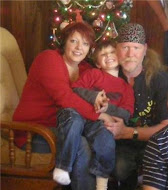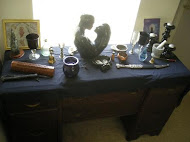A chandler is the craft person who makes it possible to see at night. The craftsperson makes candles.
One of the nicest folk-customs still practiced in many countries, and especially by Witches in the British Isles and parts of the U.S., is to place a lighted candle in each and every window of the house (or at least the windows that faced the street), beginning at sundown on Candlemas Eve (February 1st), allowing them to continue burning until sunrise. Make sure that such candles are well seated against tipping and guarded from nearby curtains, etc. What a cheery sight it is on this cold, bleak and dreary night to see house after house with candle-lit windows! And, of course, if you are your Coven's chandler, or if you just happen to like making candles, Candlemas Day is the day for doing it. Some Covens hold candle-making parties and try to make and bless all the candles they'll be using for the whole year on this day.
~~ Candlemas: The Light Returns
By Mike Nichols; August 28, 2000
* The Chandler's Craft *
By Willow Ragan
Candles...
The very word evokes calm, mystery, warmth, romance and to those of us who walk in the ways of our ancestors: ceremony and ritual. Candles are as popular today as they were necessary as the only source of illumination in the not so distant past. In this day and age, candles are available in an ever-increasing variety of shapes, colors and scents. Scented, colored candles may work wonders in the bathroom while we soak in a hot tub, they may add a two-fold accent to a dinner-table setting or a casual get-together. Or they may give you a real headache if you're allergic to the synthetic perfumes used to give them their "unique" scents.
But what about ritual and magical purposes? Do you really want altar candles smelling of Gardenias and Sandalwood? Is cherry, blueberry or new mown hay the scent you had in mind when you carefully crafted your magical working? Has anyone been able to find good "old-fashioned" unscented, pillar or quarter candles recently? Well, maybe you have, but not in these parts and even in larger urban centers it's getting more and more difficult. From this frustration was born the idea for an article on the fine art of candle making. I realize many of you are probably too busy (as I often am) to make your own candles. Nevertheless you may find the odd afternoon or two that can be devoted to making up a stock of special or all-purpose candles.
Candle making can be approached as a form of ritual, no different than the crafting of an amulet or the making of an herbal charm. Making candles in consecrated space? Why not! They can be crafted on different days of the week or different phases of the moon and sun depending on their purpose. They can be made to specific color and scent combinations depending on the type of work of you'll be using them for. Powdered herbs can be added to the hot wax before pouring, small pieces of appropriate stone such quartz can be encrusted on the outer surface. The possibilities are endless.
In this article we'll be looking at the construction of the candles themselves. Information regarding the attributes of color, scent, herb and stones would turn a short article into a book far exceeding the size of this publication. At then end of the article you'll find a resource listing of candle making supply distributors, essential oils and bulk herb suppliers.
Candles
There are three types of candles: poured (molded), rolled and dipped. Depending on the method of fabrication, the wax can consist exclusively of beeswax, paraffin, or a mix of the two. Molded candles can have any shape or size, from multiple wicked pillars to delicate star or flower shapes suitable for floating in a bowl or goblet of water. They are usually made of pure paraffin or a mix of paraffin and beeswax. Rolled candles are made with sheets of beeswax that can be shaped into tapers, pillar and cones. Dipped candles come as tapers and can be made of pure beeswax, paraffin or a mix. With molded and dipped candles scent can be added to the molten wax, either through infusing herbs in the hot wax or by adding essential oils. Color can also be added to the hot wax. With rolled candles, scent is added to the wick. Beeswax sheets are available in many colors from their natural honey-beige through the usual white, black, reds, blues, greens and yellows. Some suppliers also carry metallic gold, silver and copper.
Wax
- Beeswax - It takes an estimated 160,000 bees to make 60 pounds of honey that will yield about 1 pound of wax. When female worker bees excrete the wax, it is relatively white and odorless. The depth of its color and fragrance are determined by the use the wax was put to in the hive and the type of flower the bees were feeding from. Beeswax candles burn longer than paraffin candles, they are also dripless making them safer to use with ornate altar-cloths.
- Paraffin - Paraffin, a petroleum product, revolutionized candle making in the 1860s. The addition of stearic acid, a purified form of tallow (hardened beef or sheep fat) makes the candles opaque and improves their burning quality. Acting as a hardening agent, 2 tbs. of stearic acid per pound of wax will produce a candle that drips less.
- Blend of beeswax and paraffin - When making molded candles it is advisable to use a blend of beeswax and paraffin. According to Canadian candle maker William Nelson, the perfect candle is 51% beeswax, 10% stearic acid and 39% paraffin. Using more than 51% beeswax yields a candle that is tacky to the touch and difficult to unmold. Pure beeswax poured candles can be made using heatproof containers that serve the dual purpose of mold and candleholder. One could also experiment with cardboard or thick paper containers such as milk cartons and hot beverage paper cups, these could simply be peeled away once the candle was hardened. Any bumps or lines from these "molds" can be burnished away by gently rubbing it with a finger.
Additives
Adding scent to candles can be accomplished in several ways. The method used will vary depending on the type of candle and the form of scent being used.
- Oil - Personally I prefer essential oils, it's what I recommend for adding scent to any magical or ritual preparation. To begin with, an oil created in living plant by the Mother is going to have a very different "feel" than synthetic chemicals mixed in a test-tube by someone whose sole objective is to make money. Secondly, I have yet to meet someone who has reacted badly to essential oils being used as air-borne scent (direct application of most undiluted essential oils to the skin is not recommended). Synthetic scents make me sneeze and give me a headache, included those is almost all of the most expensive perfumes. And finally synthetic candles scents are often simply too strong. With essential oils experimentation is necessary. The scent in the bottle may change when heated. To test, place a drop or two on a light. As the oil heats, its scent will diffuse, you'll then have a good idea of what the final product will be. Do not use "scented oils" such as perfumed oils or massage oils. The carrier base brings unnecessary additives to the wax and can affect the burning quality. Oils should be added to the hot wax just prior to pouring or dipping. The recommended amount is no more than 1/4 tsp. per pound of wax, or 1/2 fluid ounce per 5 pounds of wax. Stir it in well to distribute the oil throughout the wax so that it won't leave spots of discoloration as the wax hardens. Another way of adding oils to candles is to soak the wick in a small amount of oil before placing it in the mold or dipping. This is the method for adding scent to rolled candles.
- Herbal Infusion - To add the scent and magical properties of herbs to candles, the herbs and flowers can be infused directly in the hot wax. Heat the wax to pouring temperature and add the herbs. Maintain this temperature for 45 minutes, then strain the wax. Depending on the herb used, the scent with this method may be much softer than with essential oils. Some plants such as Rosemary and Lavender have more aromatic oils and will give a stronger scent. Essential oils could be added after straining to increase the scent.
- Dried Herbs - Adding crushed dried herbs to the wax before pouring (this can only be used for molded candles) will give a dappled appearance. Use loose dried herbs and matching essential oils for scent. The herbs will tend to drift towards the bottom of the candle.
- Herbs and Oils - Herbs and oils can be used in combination, as most magical formula call for several plants, some could be added as oils, infused herbs and others as dried herbs.
Color
Color can be added by two means. By using special candle dyes available through candle supply distributor and craft shops, or by using good quality wax crayons. Candle dyes will come with instructions. Wax crayons give a more pastel shading. Use no more than 1/2 crayon per pound of wax. Grate the crayon and add it to the melted wax. Stir it well to evenly distribute the color, to judge what the final color will look like, drop a teaspoon of the melted wax into a saucepan of cold water. It will set immediately, the color of the sample will be slightly lighter and less opaque than the finished candle.
***Note: some brands of crayons have been found to have asbestos in them. So research the brand that you will use for coloring to make sure that your candles are safe.
Equipment
Now that we've gone through the different substances used in candle making let's look at the equipment needed.
- For molded and poured candles an electric deep-fat fryer or slow cooker can be used. These can often be found at garage sales or flea markets. They're great if you're going to be making large amounts of candles. They are also safer because the heating element is enclosed - wax that comes into contact with an open flame can flash into a fire. If you don't have, can't find or won't sacrifice (if you use it for candles you can't cook in it again) your cookware, a double boiler can be improvised by using a pot of water and a large coffee or juice can. If using a tin can, crimp one section of the edge to make a pouring lip. The nice thing about the fryer or cooker is that they often have thermometers and you can set them to the exact temperature you require.
- In either case you'll need a candy thermometer to determine when the wax has reached pouring temperature. The smoothness of the finish (outside layer) is dependent on the temperature at pouring time.
- A melting pitcher or something heat proof to pour the hot wax from, preferably stainless steel with a pouring lip and handle.
- Potholder or oven mitt for handling the hot pitchers of wax. You could use a soup ladle in a pinch but it might get very messy, this is hot wax we're dealing with here.
- Which is why you want to cover your "pouring/dipping" area with heavy-duty aluminum foil or wax paper.
- Measuring spoons for oils, and stearic acid.
- Wooden skewers or knitting needles for stirring the hot wax and poking the still melted candle (this prevents stir bubbles).
- Scissors for cutting wicks.
- Wick rod, a small rod that is strong enough to tie the wick to in mild setups - pencils, small skewers, strong wire rod.
- Non-stick cooking spray wiped on the inside of the mold with a cloth, this helps the candle come out of the mold more easily.
- A sharp knife or pizza cutter and smooth cutting surface for making rolled candles.
- And of course, wax
- stearic acid
- wicking material
- crayons or wax color
- essential oils
- herbs
- molds.
- There are other tools needed for special techniques such as appliqué, they'll be enumerated when those topics are covered.
Methods of Fabrication
- How much wick - For molded and rolled candles, the wick should be at least 1/2 inch longer then the desired height of the candle. For dipped candles, see that section. Size 1/0 square braided wick will work in candles from 1/2 inch to 3 inches in diameter. Wick should be trimmed to 1/4 inch before burning.
- Molded candles - Prepare each mold by wiping the inside with a cloth that has been sprayed with cooking spray. If you're using milk cartons or other peel-away mold, skip this step. Place the wicking securely in the mold, if you're using peel-away molds, coat the wicking with wax so that it dries straight, put a small dab of hot wax in the bottom of the "mold" and stick the wick to it. Then wrap the top end around a pencil or skewer laid across the top of the mold.
The mold is now ready to receive the molten wax. Melt the wax (and stearic acid, crayon or color buds if desired) and stir. Bring it to the recommended pouring temperature. This will be between 160 F and 190 F depending on the wax, follow the directions that come with the wax you buy. When the wax has reached the correct temperature add scent and dried herbs if you like. Pour the wax into the molds to the desired height. As the wax cools, the top, which becomes the bottom of the candle if you're using a commercial mold, will shrink and develop a hollow. Using a knitting needle poke through the surface a few times to eliminate any air pockets, then fill the depression with more wax. You may need to do this several times, depending on the size of your candle, to level off the top. Leave the candle to cool and harden 12 to 24 hours before removing it from the mold. - Dipped candles - To make dipped candles, you need to use a pot that is a least 1 inch deeper than the desired length of the candles. You will also need to keep the wax topped off to the same level even as the candles increase in size. You also need to set up a drying rack before you begin making the candles. This "rack" can be made by laying a 2-3 inch wide piece of wood across the back of two chairs that are set a few feet apart. Put newspaper on the floor for the dripping wax to fall on. Any wax can be used, including pure beeswax. Wax temperature must remain constant - between 160 F and 170 F. If the wax is too hot, the previously accumulated wax will melt off, if it is too cold, the new layer will be lumpy.
To make tapers, loop lengths of small-sized wicking about a foot longer than the desired length of the two candles. Each pair should be separated from other pairs by two to three inches along the edge of the board. Heat the wax as usual, and dip the wick in the wax to the depth of the desired length of candle for about five seconds. Placed the freshly dipped candles on the rack to set. Expect about 40 dips to produce a pair of candles a bit less than 1 inch wide across at the base. - Rolled Candles - The basic thing to know about rolling beeswax candles is that they seem to roll the best at normal room temperature (70 -80 F). If the wax is too cold, it will not "want" to roll and may crack. At the very least it will not stick to itself and your candle will be loose and not burn well. If the wax is too warm it will be too soft to roll, the pattern in the wax will get flattened out while rolling, and your finger will leave dents in the candle. The most important thing is to get good contact between the wax sheet and the wick. Therefore, the first wrap is the most critical.
Press the wick into the wax on all sides. Spread you finger along the length of the candle for even rolling, the outer edge simply gets pressed into the candle. If you like, slightly heat the wax (or a butter knife) to help blend the outer edge into the candle. This will help keep the candle from unraveling. The sheets are generally 8 x 16 inches, wide and long enough to make tapers, pillars and cones. - Rolled Tapers - To make a pair of 8 inch tapers, use one sheet. Cut the sheet in half, place the wick along one edge. Roll it carefully, watching the edges to help you roll straight. For a tapered look, cut a small triangle off the top and start rolling from the longest end. Roll the same direction on the sheet so that the honeycomb pattern looks the same on both candles. To make 4 inch tapers, cut the sheet into 4 inch intervals, place wick along 4 inch edge and roll towards the opposite end. This is also the direction to roll in if you want to make single 12 or 16 inch tapers. One sheet will yield one 16 or one 12 and one 4 inch taper.
- Rolled Pillars - To make a 4 inch pillar, approximately 2.5 inches in diameter requires two full sheets. Place the sheets on top of the other and cut the sheets in half length-ways. Place the wick along the 4 inch edge of one of the 4 x 16 inch sheets and roll tightly and evenly around the wick. After rolling that entire sheet into a small pillar candle, place the next sheet end to the end of the sheet you've just rolled and continue rolling, making sure that the top edge remains aligned. Continue doing this till all four sheets have been rolled into your pillar candle. The uncut edges are usually more attractive than the freshly cut edges, so position the sheets so that the newly cut edge will be on the bottom. You can also make an 8 x 3 inch pillar by using three sheet of wax, just place the wick along one end and roll as with the other candles, then place the second sheet against the edge of the first sheet and roll. Repeat with the third sheet.
- Rolled Cones - Spirals or cones happen because of a diagonal cut in a sheet of wax that is rolled against the straight edge of the sheet. Sheets can be placed end to end (with varying colors if desired) before the cut is made. This will yield two 8 inch spirals.
Special Techniques
Candles can be decorated by using and appliqué method. Pressed herbs and flowers or wax forms can be applied to candles. Appliqué is best suited to pillar candles, either round or square will do.
- Wax Appliqué
For this technique you'll need: - a "core" candle
- a cookie cutter in the desired shape (star, flower, etc.) or sharp knife to carve with if you're using a symbol that isn't available in cookie cutter form
- wax
- color
- scent
- a baking pan to make the forms in
- a bowl to hold warm water
- a bowl to hold cold water
- a small paintbrush
- . If you're using an original design or runic form it's best to draw and cut a template on fairly rigid cardboard like poster-board or even using a file-folder.
Prepare some colored wax for your appliqué, the amount of wax you prepare will depend on how many candles you are decorating and how many designs you use per candle. Pour 1/16( to 1/8( layer in the bottom of the baking pan. Allow it to cool until solid, but still warm. Press the cookie cutter into the wax or position your template and cut around it with a sharp knife. Remove the excess wax from around the shapes and allow them to cool completely. Removing them before they harden may distort the pattern. When they are completely cool remove the shapes from the pan and place them in a bowl of warm tap water until soft. When soft, remove from water and gently burnish the sides with your finger, this is to smooth out cut marks. Then immediately press against the core candle. Once the appliqué has taken the curvature of the candle, place it in cold water immediately. Repeat for all the appliqué. To attach the appliqué to the candle, apply tacky wax to the back of the appliqué and gently press to the candle. Repeat until complete. - Herbal appliqué
For this you'll need - a "core" candle
- some hot wax
- a small flat paintbrush
- the herbs of your choice.
Herbs and flowers used for this purpose need to be pressed and dried for a few days in a plant press or substitute, such a phone book. Arrange the pressed flowers and herbs on your work surface. Dab them with a bit of white glue or hot wax and immediately position them on the candle, pressing them onto the surface until the wax hardens or glue dries and they are held firmly in place. Coat the design with a thin layer of hot wax to hold the herbs in place permanently and to keep them from being scuffed and broken. There are various ways of doing this. The simplest way is to paint hot wax onto the candle's surface until the herbs are completely coated. To produce a smoother, flatter surface, you can dip the entire candle by its wick for a few seconds into melted wax up to its upper edge. Don't fill the wax container to the top because as you dip the candle it will displace its volume in wax and the level will rise; experiment to find out how much wax it takes and use a double boiler so that any overflow goes into the surrounding water.
There you have it, everything you may (or not) have ever wanted to know about candle making, so gather round a few of your friends, heat up some wax and enjoy the time honored craft of chandling.
Bibliography
Beeswax, History and Use. Roger A. Morse, Department of Entomology of Agriculture and Life Sciences, Cornell
Elementary, My Dear Chandler, Harrowsmith Country Life Reader, 1990, Camden House Pub.
Light up your Life, The Herb Companion, Oct/Nov 1994.
Lumina, on-line articles
WaxedOut Candles, on-line articles
Disclaimer: No one involved in this blog or its contents may be held responsible for any adverse reactions arising from following any of the instructions/recipes on this list. It is the reader's personal responsibility to exercise all precautions and use his or her own discretion if following any instructions or advice from this blog.















No comments:
Post a Comment